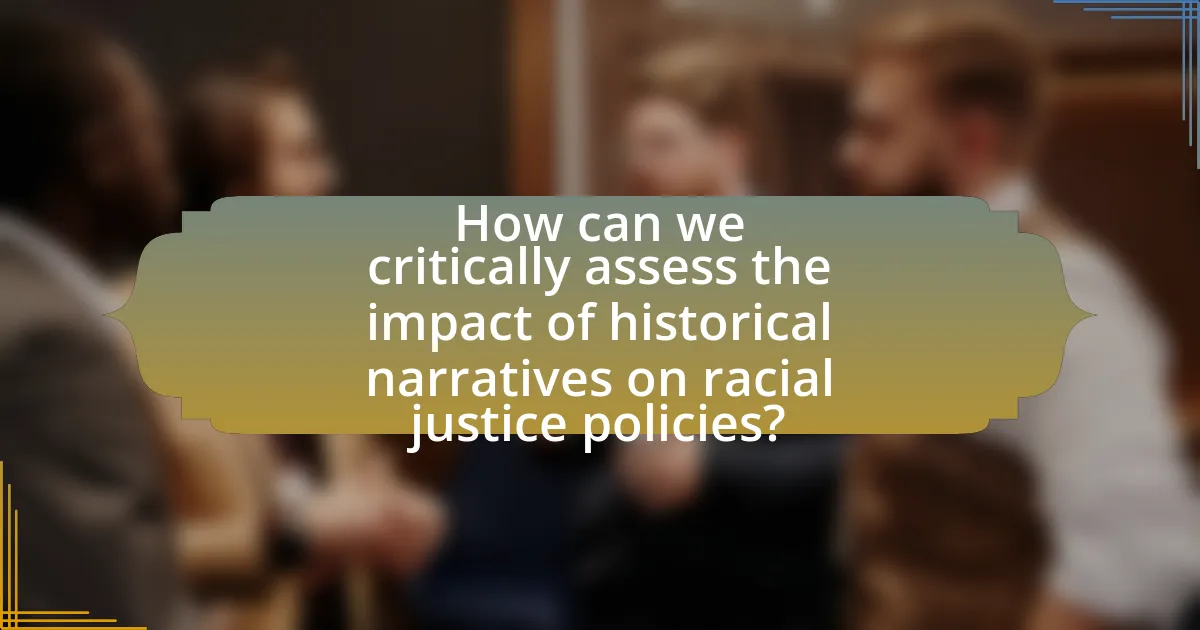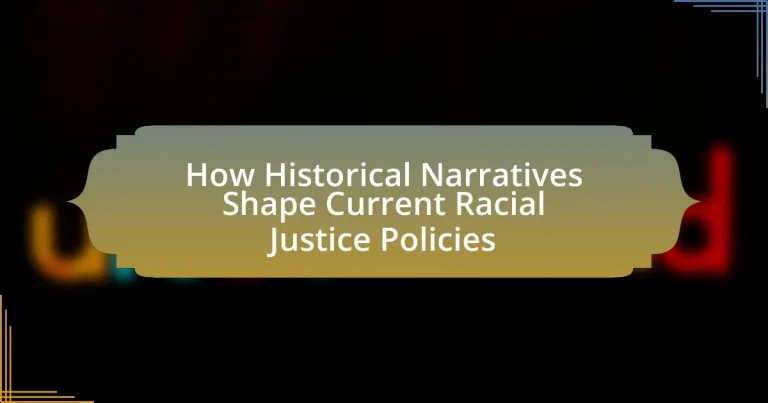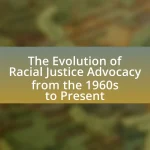The article examines how historical narratives influence current racial justice policies, emphasizing the impact of events such as slavery, segregation, and the Civil Rights Movement on contemporary public perception and policy formulation. It highlights the significance of understanding historical context in shaping advocacy strategies and community engagement, as well as the role of specific narratives in informing policy initiatives aimed at addressing systemic inequalities. The discussion includes the evolution of these narratives over time, their varying interpretations across different racial and ethnic groups, and the implications for future racial justice efforts. Additionally, it outlines methodologies for analyzing the influence of history on policy and suggests best practices for incorporating accurate historical narratives into racial justice advocacy.

How do historical narratives influence current racial justice policies?
Historical narratives significantly influence current racial justice policies by shaping public perception and understanding of racial issues. These narratives, often rooted in historical events such as slavery, segregation, and civil rights movements, inform the frameworks through which society interprets contemporary racial disparities. For instance, the legacy of systemic racism highlighted in historical accounts has led to policy initiatives aimed at addressing inequalities, such as affirmative action and criminal justice reform. Research indicates that communities with a strong awareness of their historical context are more likely to advocate for policies that promote equity and justice, as seen in movements like Black Lives Matter, which draw on historical injustices to mobilize support for current reforms.
What role do historical events play in shaping public perception of racial justice?
Historical events significantly influence public perception of racial justice by providing context and shaping collective memory. For instance, landmark events such as the Civil Rights Movement in the 1960s, which included pivotal moments like the March on Washington and the passage of the Civil Rights Act, have established a framework for understanding racial inequality and justice in the United States. These events are often referenced in contemporary discussions, reinforcing the idea that racial justice is an ongoing struggle rooted in historical injustices. Additionally, the legacy of slavery and segregation continues to inform public attitudes, as evidenced by surveys indicating that awareness of historical discrimination correlates with support for current racial justice initiatives. Thus, historical events serve as critical reference points that shape how society perceives and responds to issues of racial justice today.
How do specific historical events inform contemporary racial justice movements?
Specific historical events, such as the Civil Rights Movement of the 1960s, inform contemporary racial justice movements by providing a framework for activism and policy advocacy. The Civil Rights Movement, marked by significant events like the March on Washington in 1963 and the Voting Rights Act of 1965, established key strategies for mobilization, legal challenges, and public awareness that are echoed in today’s movements like Black Lives Matter. These contemporary movements draw on the historical context of systemic racism and the ongoing struggle for equality, using lessons learned from past successes and failures to shape their approaches. For instance, the use of social media in current movements mirrors the grassroots organizing tactics of the past, demonstrating how historical narratives continue to influence methods of advocacy and community engagement in the fight for racial justice.
What narratives have emerged from historical injustices that affect current policies?
Narratives that have emerged from historical injustices, such as colonialism, slavery, and segregation, significantly influence current policies on racial justice. For instance, the narrative of systemic racism, rooted in the legacy of slavery in the United States, has led to policies aimed at addressing disparities in criminal justice, education, and housing. The 1619 Project highlights how the history of slavery continues to shape societal structures and informs contemporary discussions on reparations and equity. Additionally, the narrative of Indigenous rights, stemming from colonization and land dispossession, has prompted policies aimed at recognizing sovereignty and addressing historical grievances, as seen in the United Nations Declaration on the Rights of Indigenous Peoples. These narratives underscore the importance of acknowledging historical injustices to inform and guide current policy-making in pursuit of racial equity and justice.
Why is understanding history crucial for effective racial justice advocacy?
Understanding history is crucial for effective racial justice advocacy because it provides context for current racial inequalities and informs strategies for change. Historical events, such as slavery, segregation, and discriminatory laws, have shaped systemic racism and social structures that persist today. For instance, the legacy of redlining in the United States has resulted in significant wealth disparities among racial groups, with studies indicating that Black families are often denied equal access to housing and financial resources. By comprehending these historical injustices, advocates can better address the root causes of racial disparities and develop informed policies that promote equity and justice.
How can historical context enhance the effectiveness of racial justice initiatives?
Historical context enhances the effectiveness of racial justice initiatives by providing a framework for understanding systemic inequalities and informing targeted strategies. Recognizing the historical roots of racial disparities, such as the legacy of slavery, segregation, and discriminatory policies, allows policymakers to address specific issues that have persisted over time. For instance, the Civil Rights Movement of the 1960s highlighted the need for legal reforms, which led to the enactment of the Civil Rights Act of 1964 and the Voting Rights Act of 1965, directly addressing injustices rooted in historical oppression. By integrating historical context, initiatives can be more effectively tailored to dismantle existing structures of inequality and promote equitable outcomes.
What lessons from history can inform current racial justice strategies?
Historical movements for racial justice, such as the Civil Rights Movement in the United States, demonstrate the importance of grassroots organizing and coalition-building in achieving systemic change. The Civil Rights Movement, which included significant events like the Montgomery Bus Boycott and the March on Washington, showcased how collective action can challenge oppressive systems and lead to legislative reforms, such as the Civil Rights Act of 1964 and the Voting Rights Act of 1965. These historical examples highlight that sustained activism, public awareness campaigns, and legal challenges are essential strategies for current racial justice efforts. Additionally, the lessons learned from the failures and successes of past movements emphasize the need for intersectionality, recognizing how various forms of discrimination intersect and affect marginalized communities.

What are the key historical narratives that shape racial justice policies today?
Key historical narratives that shape racial justice policies today include the legacy of slavery, the Civil Rights Movement, and systemic racism. The legacy of slavery established deep-rooted inequalities that persist in economic, educational, and social structures, influencing contemporary policy discussions. The Civil Rights Movement of the 1960s, marked by landmark legislation such as the Civil Rights Act of 1964 and the Voting Rights Act of 1965, laid the groundwork for ongoing advocacy for racial equality and justice. Systemic racism, evidenced by disparities in criminal justice, housing, and healthcare, continues to inform policy debates and reform efforts aimed at addressing these inequities. These narratives collectively inform the frameworks and strategies employed in current racial justice initiatives.
Which historical narratives are most prevalent in discussions of racial justice?
The most prevalent historical narratives in discussions of racial justice include the legacy of slavery, the Civil Rights Movement, and systemic racism. The legacy of slavery highlights the long-term impacts of enslavement on African American communities, emphasizing economic disparities and social injustices that persist today. The Civil Rights Movement narrative focuses on the struggle for equality and the legal advancements achieved through activism, such as the Civil Rights Act of 1964, which aimed to dismantle institutional discrimination. Systemic racism narratives illustrate how policies and practices in various sectors, including education, housing, and criminal justice, perpetuate racial inequalities, supported by studies showing significant disparities in outcomes based on race. These narratives collectively inform contemporary discussions and policies aimed at addressing racial justice issues.
How do these narratives differ across various racial and ethnic groups?
Narratives differ across various racial and ethnic groups primarily due to distinct historical experiences and cultural contexts. For example, African American narratives often emphasize the legacy of slavery and systemic racism, which shapes their perspectives on justice and equality. In contrast, Native American narratives focus on colonization, land dispossession, and cultural survival, influencing their calls for sovereignty and reparative justice. Hispanic narratives may highlight immigration experiences and labor rights, reflecting their struggles for recognition and equity in society. These differences are supported by historical events such as the Civil Rights Movement for African Americans, the Indian Removal Act for Native Americans, and the Bracero Program for Hispanic communities, which have all shaped the unique narratives and demands for justice within each group.
What impact do these narratives have on policy formulation and implementation?
Historical narratives significantly influence policy formulation and implementation by shaping public perception and political discourse around racial justice. These narratives provide context and justification for policies, often reflecting societal values and historical injustices. For instance, the civil rights movement’s narratives have led to the establishment of affirmative action policies, which aim to address systemic inequalities. Research indicates that narratives emphasizing historical discrimination can mobilize public support for policies aimed at rectifying these injustices, as seen in the increased advocacy for reparations in recent years. Thus, the impact of these narratives is evident in their ability to frame issues, guide legislative priorities, and affect the allocation of resources toward racial justice initiatives.
How have historical narratives evolved over time in relation to racial justice?
Historical narratives have evolved significantly over time in relation to racial justice, reflecting changing societal values and awareness. Initially, narratives often marginalized or omitted the experiences of racial minorities, focusing predominantly on dominant cultural perspectives. For example, the portrayal of slavery in American history was often sanitized, emphasizing economic factors over the human suffering involved.
As civil rights movements gained momentum in the mid-20th century, historical narratives began to incorporate the voices and experiences of marginalized groups, highlighting systemic injustices and the struggle for equality. The publication of works like “The Autobiography of Malcolm X” and the establishment of Black History Month in the 1970s contributed to a broader understanding of racial justice.
In recent years, the rise of social media and movements such as Black Lives Matter has further transformed historical narratives, making them more inclusive and reflective of contemporary issues. This evolution is evidenced by the increased focus on intersectionality and the acknowledgment of systemic racism in educational curricula and public discourse.
Overall, the evolution of historical narratives in relation to racial justice illustrates a shift from exclusion to inclusion, shaping current racial justice policies by fostering a more comprehensive understanding of history and its impact on present-day inequalities.
What factors contribute to the changing narratives surrounding racial justice?
The changing narratives surrounding racial justice are influenced by social movements, media representation, and evolving legal frameworks. Social movements, such as Black Lives Matter, have mobilized public opinion and highlighted systemic injustices, prompting shifts in how racial issues are perceived. Media representation plays a crucial role by shaping public discourse; for instance, increased visibility of racial violence through social media has led to greater awareness and urgency for change. Additionally, evolving legal frameworks, such as recent reforms in policing and criminal justice, reflect and reinforce these changing narratives, demonstrating a societal shift towards addressing racial inequities.
How do contemporary movements reinterpret historical narratives for current advocacy?
Contemporary movements reinterpret historical narratives by emphasizing marginalized voices and experiences to advocate for social justice and policy change. For instance, the Black Lives Matter movement draws on the historical context of systemic racism and police violence against Black individuals, framing these issues as part of a long-standing struggle for civil rights. This reinterpretation is supported by historical events such as the Civil Rights Movement of the 1960s, which serves as a reference point for ongoing advocacy. By connecting past injustices to present-day issues, these movements aim to mobilize public support and influence policy reforms that address racial inequities.

How can we critically assess the impact of historical narratives on racial justice policies?
To critically assess the impact of historical narratives on racial justice policies, one must analyze how these narratives shape public perception and policy formulation. Historical narratives often frame the context of racial issues, influencing lawmakers and the public’s understanding of systemic inequalities. For instance, the portrayal of the Civil Rights Movement in educational curricula can affect contemporary views on racial justice, as evidenced by studies showing that inclusive historical education correlates with greater support for equitable policies. Furthermore, examining specific case studies, such as the impact of the 1619 Project on discussions around reparations, illustrates how historical interpretations can mobilize or hinder policy initiatives. Thus, a critical assessment involves evaluating both the content of historical narratives and their reception in shaping racial justice outcomes.
What methodologies can be used to analyze the influence of history on current policies?
Qualitative analysis and historical institutionalism are methodologies that can be used to analyze the influence of history on current policies. Qualitative analysis involves examining historical documents, narratives, and case studies to understand how past events shape contemporary policy decisions. For instance, analyzing legislative debates and public records can reveal how historical injustices inform current racial justice policies. Historical institutionalism focuses on the role of institutions and their historical development, demonstrating how past policy choices create path dependencies that affect present-day governance. This methodology can be illustrated by examining how historical laws, such as Jim Crow, continue to influence modern legal frameworks and racial disparities in the United States.
How can qualitative and quantitative research contribute to this analysis?
Qualitative and quantitative research can significantly contribute to the analysis of how historical narratives shape current racial justice policies by providing comprehensive insights and empirical data. Qualitative research, through methods such as interviews and focus groups, uncovers the lived experiences and perceptions of individuals affected by racial policies, revealing how historical narratives influence their understanding of justice and equity. For instance, studies have shown that personal narratives can highlight systemic injustices, thereby informing policy discussions.
Quantitative research complements this by offering statistical evidence that can validate or challenge these narratives. For example, data analysis on racial disparities in criminal justice outcomes can illustrate the impact of historical policies on current practices. Research published in the “American Journal of Sociology” indicates that statistical correlations between historical segregation laws and present-day incarceration rates provide a clear link between past and present racial injustices. Together, these research methodologies create a robust framework for understanding the complex interplay between historical narratives and contemporary racial justice policies.
What role do community narratives play in shaping policy assessments?
Community narratives significantly influence policy assessments by providing localized insights and perspectives that reflect the lived experiences of individuals within a community. These narratives can highlight specific issues, needs, and values that may not be captured through traditional data sources, thereby informing policymakers about the real-world implications of their decisions. For instance, research by the Urban Institute indicates that community input can lead to more equitable policy outcomes, as it allows for a deeper understanding of the social dynamics and historical contexts that shape community challenges. By integrating these narratives into policy assessments, decision-makers can create more responsive and effective policies that address the unique circumstances of diverse populations.
What are the implications of historical narratives for future racial justice initiatives?
Historical narratives significantly influence future racial justice initiatives by shaping public perception and policy frameworks. These narratives provide context for understanding systemic inequalities and injustices faced by marginalized communities, which can inform the goals and strategies of racial justice movements. For instance, the historical account of the Civil Rights Movement highlights the importance of grassroots organizing and legal challenges, which continue to inspire contemporary initiatives aimed at combating racial discrimination. Furthermore, research indicates that acknowledging historical injustices, such as slavery and segregation, can foster a sense of urgency and moral responsibility among policymakers and the public, leading to more robust support for equitable policies. Thus, the implications of historical narratives are profound, as they not only inform the objectives of racial justice initiatives but also mobilize collective action towards achieving systemic change.
How can policymakers leverage historical narratives to promote equity?
Policymakers can leverage historical narratives to promote equity by using them to highlight systemic injustices and inform contemporary policy decisions. By integrating historical accounts of discrimination and inequality, such as the impact of redlining on housing access for marginalized communities, policymakers can create a framework that acknowledges past wrongs and addresses their ongoing effects. Research indicates that understanding historical context, like the legacy of Jim Crow laws, can guide equitable policy-making by ensuring that solutions are tailored to rectify specific injustices. This approach not only fosters awareness but also builds public support for policies aimed at achieving equity, as evidenced by initiatives that draw on historical injustices to advocate for reparative measures.
What best practices can be adopted to ensure historical narratives are accurately represented in policy-making?
To ensure historical narratives are accurately represented in policy-making, it is essential to incorporate diverse perspectives and engage with historians and community stakeholders. This practice allows for a more comprehensive understanding of historical events and their implications on current racial justice policies. For instance, the inclusion of marginalized voices in historical accounts can reveal systemic injustices that have shaped contemporary issues, as seen in the work of scholars like Ibram X. Kendi, who emphasizes the importance of understanding history to address racial inequities. Additionally, utilizing data-driven approaches, such as historical analysis and demographic studies, can provide empirical evidence that supports the integration of accurate narratives into policy frameworks. This method not only enhances the credibility of the policies but also fosters public trust and accountability in governance.
What practical steps can advocates take to incorporate historical narratives into racial justice efforts?
Advocates can incorporate historical narratives into racial justice efforts by integrating educational programs that highlight the historical context of racial issues. These programs can include workshops, community discussions, and curriculum development that focus on significant events such as the Civil Rights Movement and systemic injustices faced by marginalized communities. For instance, the Southern Poverty Law Center’s Teaching Tolerance initiative provides resources that help educators teach about the history of racism and its impact on society. Additionally, advocates can collaborate with historians and community leaders to create public art installations or digital storytelling projects that reflect local histories of racial injustice, thereby fostering a deeper understanding of the ongoing effects of these narratives.


